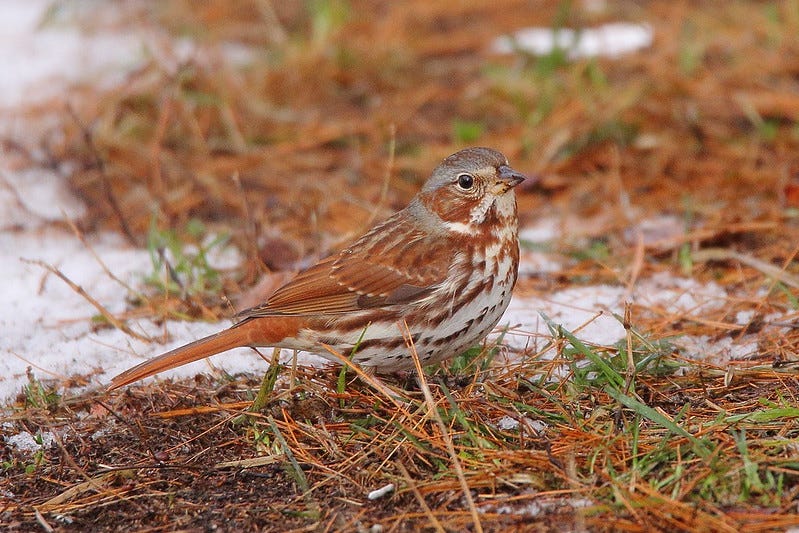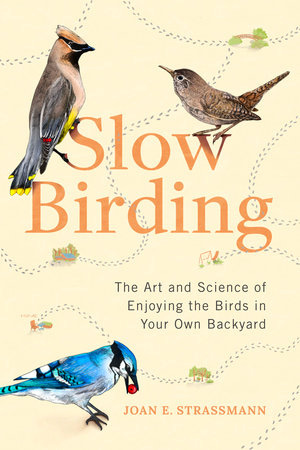Birding Western Mass - tales of sparrow-fu, killdeer soon, "Slow Birding"
Thoughts on Birding from the Quabbin to the Berkshires
In this issue:
A Day at Turner’s Falls
Killdeer will be back soon
Focus: Flock inspection for fox sparrows
Review: Slow Birding
Four weeks after I tested positive for Covid, I could finally get back out with binoculars last week. This was a great gift and I am thankful. I feel fine; I’m running at 90+%. I probably got in 4 miles on Saturday, and I feel lucky that I could. I know not everyone can, even on their best days, and I do not take this for granted.
The cold last weekend was definitive. The Turners Falls waterscape was mostly frozen over. The currents in the river there that respond to the dams’ influence were difficult to predict. At Unity Park there was open water, with swans and gulls. Also there was open water in the power plant reservoir in some places; an eagle soared over it, its fairly commonplace presence a reminder of what people can do when a charismatic creature inspires them to action. I spent a few hours there and was struck by how the mixture of ice floes in the reservoir grew from scraps to a slurry as the current shifted.
I had the usual ducks and the mute swans in the reservoir. I went downhill from the parking area at that little trail through the scruffy woods to see if there was water downstream of the plant. There was; the river ran swiftly.
Immediately, I saw a Barrow’s goldeneye. That’s a sea duck; the head is dark purple as Welch’s grape jelly; it has a stark white blotch on its cheek; a series of small pale windows is striped along its back (which was a field mark that I noted and then saw clearly in my field guide).
It was being borne downstream even as it pushed at the current. A tiny standing wave folded over itself at the duck’s breast, the way a ripple does on a rowboat working against a tide.
Thank you for reading this newsletter. The rest of the week’s thoughts follow, including consideration of how to spot fox sparrows among their kin species, a book review, and a note about one of the earliest signs of spring: A counterintuitive sandpiper.
FYI, this newsletter will always be free. If Substack suggests you pledge something, or something similar, just ignore it.
Study Up
Impossibly but predictably, killdeers will arrive soon. It’s time to tune your ear for their arrival. I hear them before I see them; maybe you do, too. In the first week of February, there are essentially zero killdeer here, but in the third week, a few will likely arrive. In the first week of March the increase will be notable and then a week or so later their numbers start to grow very significantly. This link will show you the eBird curve.
Killdeer are sandpipers that live away from water. They have the unfortunate habit of nesting in open places where humans aren’t often present, like gravelly roads, but where when humans do show up, it’s not a good place to raise small killdeer in the egg or tiny bird phase. I’ve seen killdeer nests on sporting fields more than once, most memorably at home plate on a softball diamond in Shrewsbury, Mass.
They’re looking for sand with no water nearby. However, they ignore the risks that come from creatures like us passing through on foot or wheel. Nor can they process the fact that secluded gravel rooftops are unlikely to offer the necessary insect prey for their chicks.
The result is that parents sometimes successfully hatch their eggs on a rooftop but then have to get the small birds off. A number of stories are told in this research from Canton, including how one bird taught its chicks to treat a gutter downspout like a tunnel slide to get off the roof and onto the ground.
Focus
Fox sparrows are appearing this time of year (and are doing so slightly more often than usual). There will be a significant bounce in sightings that starts in two weeks and then sightings will peak in the earliest week of April.
The best piece of found poetry from eBird for the week comes from David Matevosian: When he reported a fox sparrow sighting, his note was “Rufous bird with a face that looks like a toddler eating carrots.”
We don’t all have this lyrical vocabulary. (I do try, but I gotta say he brought in a good one.)
Birders aren’t just focused on a single way of knowing, so this week’s focus has a bunch of ways to think about spotting fox sparrows.
Here are the systems that I encountered in corresponding with local birders about their sparrow-fu. Using these tactics for fox sparrow vs. not-fox sparrow is indeed a satisfying task. I haven’t seen one again as of this writing, but the spike is coming, and I intend to employ the below approaches.
Dave Small, of the Athol Bird Club, is skeptical that he has notable sparrow-fu. He’s had 51 sightings in ten years, which he said “doesn’t seem like a lot.” (About 80% of those were at his own feeder.) I’d disagree. I have had very few fox sparrow sightings in all my life, as I say, and I think Small, who said he simply looks “over the mixed flocks carefully” has had unusual success.
So what does it mean to look over mixed flocks carefully? One of the birders who has shown particular success this year (and others) is Nathan Senner, a professor at UMass in the Department of Environmental Conservation. Nathan was kind enough to offer a few perspectives on his observation skills.
“I usually first hear Fox Sparrows…They have a deeper, richer 'chip' note than Juncos,” he wrote in an email.
Here’s a fox sparrow tseep. (It is deeper and richer.)
“Then, I often see them quickly because they are larger and more colorful than White-throated Sparrows.” Like a toddler with carrots on their face.
Once you know, you know to keep looking: Senner thinks it’s possible he’s been relocating a fox sparrow in his neighborhood that has been associating with the juncos and white-throats, which seems plausible. He has seen it, if so, a LOT this year.
Pete Gagarin used as one of his field marks/indicator points in his eBird sighting description the double-foot backward scrape that fox sparrows employ to expose food in leaves. That’s a distinctive maneuver I will watch for.
Joshua Stuart Rose, in a very generous and thoughtful response, said he does not usually detect fox sparrows by ear. The call differences are so subtle that they’re less useful for alerting, in his experience.
Most of the time he sees them alone or with other fox sparrows. Usually, he said, he sees them in “brush piles and overgrown, brushy woodland trails and edges.”
Birding being what it is, though, which is to say a study in surprise, he said that his most recent sightings have placed them with mixed flocks, and once on the forest floor, not in a brushy place.
These factors lead me to wonder if the winter fox sparrow may be different in behavior from the spring or fall fox sparrow. Which then leads me to wonder if that’s because most / all of the individuals behave differently in winter or if the ones that stay here in winter are behaviorally distinct.
Bird Books
Winter is a time things slow down. For those of us who have yards we can and do make bird-friendly, the opportunity to watch behavior fits with the opportunity to sit in the rooms with big windows. While I was sick, I read Slow Birding, by Joan E. Strassmann. The tl; dr version of this review is that the philosophy of slow birding certainly deserves our attention. The care with which Strassmann captures the tactics of ornithologists, then translates them for civilians like us, also makes for a fine read, especially for winter days.
At greater length — Strassmann wonders early in the book why she wrote a whole such book-length thing when the advice that serves as the inspiration for the book could be exhausted in a podcast or a blog entry. Such humility has a point.
Her solution validates the decision: She provides the reader not just with templates for “slow birding” but also for empirical birding. She examines each of multiple species through the lens of academic research and considers some aspect of the bird’s behavior from multiple angles — academic, philosophical, cultural. She’s giving the reader a way that he, she or they can do the same, to learn the birds that are available for observation commonly and experience them in the outdoor world that surrounds us.
We have juncos in the yard here and I followed some of her ideas for watching and interpreting their behaviors. I’ve observed the dominance struggles she highlights and for three mornings I have taken note of the counterculture Lone Junco who returns to the scattered seed at dawn, collects a few beakfuls, and disappears. (I make a little whistling sound like the ones on Ennio Morricone soundtracks to accompany his departure into the sunrise.)
Slow birding is something we could all stand to do more. When I stopped at the Arcadia Nature Center last weekend after a disappointing walk in the Arcadia Meadows, I sat on a bench and let the woods fill my mind for a moment. I was rewarded by the idea that returning to that hilly stretch might be productive when I need a canopy view in spring — and then by a conflict between two pileated woodpeckers. Such deliberation delivers dividends, like the sparrow-fu above.
By the way, Slow Birding is available as an ebook from Libby, the app that the local library system uses. I read it that way, being able to check it out from the library without leaving the room where I was quarantined, and I’ve returned it, so you can check it out for free yourself.





Thank you! I am a huge fan of the idea of slow birding, such that I had to relocate from the room with a view of the yard. I appreciate your kind words, too.
I am so enjoying your observations, Whit, and have tried a few of your links which are quite helpful. I got Slow Birding for Christmas and am looking forward to reading it, especially after reading your comments about it! I most enjoy your more lyrical observations of your environment. The ice. The color of the bird’s eye. Lovely!